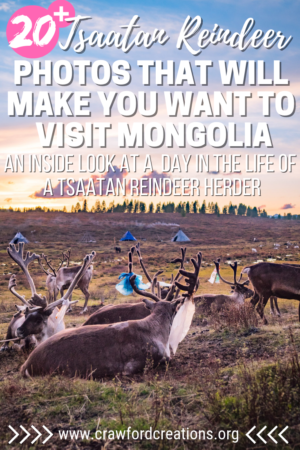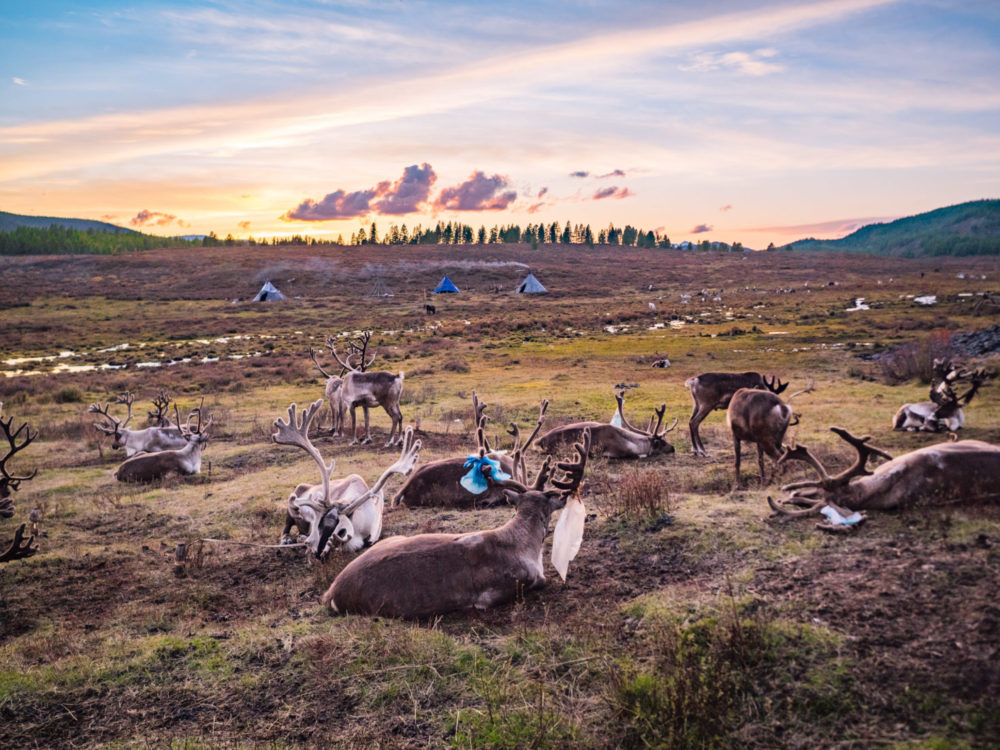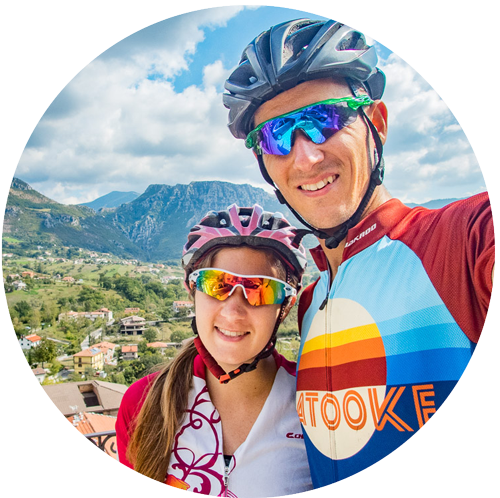A Day In The Life of Mongolia’s Tsaatan Reindeer Herders: 20+ Tsaatan Reindeer Photos That Will Make You Want To Visit Mongolia
***This post may contain affiliate links.***
Deep in the heart of the Mongolian Taiga lives Mongolia’s most unique and remote community of herders, the Tsaatan. What makes the Tsaatan so unique is not so much where they live, but how they live. While most Mongolian herder families raise cows and sheep, the Tsaatan do things a little differently. They raise reindeer.
Reindeer herding is a tradition that dates back hundreds of years. Prior to World War I, Tsaatan families roamed the land on either side of the Russian/Mongolian border. But, once the war broke out, concern over the Russian government ceasing the reindeer that they depend on so fiercely for their livelihood forced the Tsaatan to settle permanently in the northern tip of Mongolia.
And there they have remained ever since, nestled in the remote Mongolian Taiga. The nearest town, Tsagaannuur Village, is located over 30 kilometers away and is only accessible by reindeer or horse, which makes visiting the Tsaatan community quite the challenge.
Traveling to the Tsaatan camp requires a 5-6 hour horse ride through the bog, deep mud, dense forest, over steep mountain trails, and across rivers. To get there requires an adventurous spirit and a healthy dose of grit and determination. Of course, some horse experience helps as well.
Traveling to meet the Tsaatan reindeer herders is not for everyone, but, for me, it was the makings of a perfect trip.
Taiga Magic: Tsaatan Reindeer Photos From Mongolia

After 5 hours in the saddle, I reached the final hilltop where I got my first glimpse of the Tsaatan camp. Countless teepees dotted the valley before me, smoke billowing out of the tops a sign that fires were brewing inside, most likely in preparation for the days’ dinner.
My guide urged us on, pointing to the impending grey clouds as a signal to hurry up before we get caught in the rain.
We made it to camp just in time where community leaders Ganbaa and Purvee were there to welcome us into their teepee as the first raindrops fell from the sky. They warmed up a pot of milk tea which was served with homemade bread and reindeer cheese, a hearty snack after a long days ride.
After 4 years in dairy-averse China, the cheese was much appreciated. Purvee was impressed as I gratefully drank a full bowl of milk tea and generous amounts of bread and cheese.
“Most tourists don’t like it,” she said.
I’m not sure what’s not to like, although, admittedly, the reindeer milk tea is an acquired taste.

It turns out, we were staying the night in one of Ganbaa and Purvee’s spare teepees. Following our welcome snack, we moved to the empty teepee next door to unpack and make our beds for the night.
After a quick unpack my guide and I went out to help the Tsaatan herd the reindeer back to camp. The reindeer spend their days away from camp grazing and are then herded back to camp come evening and tied up for the night where they’re surrounded by the Tsaatan and their dogs for protection.

Every evening a handful of people go out to get the reindeer and herd them back to camp. Watching the group walk into camp for the first time is a sight I’ll never forget.
Once the herd gets close to camp all the family members come out to identify their reindeer and tie them to stakes in the ground near their family’s teepees. My job was simply to hold a group of reindeer so that one of the family members could come and take them one by one to be tied up in their designated spots.

While the reindeer are tied up for the night, they have no access to food or water. This is not to be cruel, but simply because they don’t need any.
Reindeer, like most types of deer, have a very low water requirement. In fact, they actually get most of their water from food and not from drinking at freely available water sources. Reindeer also spend all day roaming free and doing nothing but eating, so come nightfall, they’re ready for bed just like we are.
As someone who previously knew next to nothing about deer, it was fascinating to learn about the process of raising reindeer and how to care for them.
Once the herd has been secured for the night, the herder’s job is done and all that’s left is to prepare dinner for the night, a task usually left to the woman of the house.

Wolf howls and dog barks rang in the air late into the night as the Tsaatan stayed up in shifts periodically checking on the reindeer with flashlights. Ganbaa and Purvee told us that there have been an unusual amount of wolves in the area lately and unfortunately, one of the reindeer got attacked and injured during the night.
Luckily, it was ok, but they got a late start in the morning tending to the injured reindeer. The Tsaatan’s reindeer are like members of the family, and it’s heartbreaking to them when one gets injured or dies.
I gave them their space while they took care of their injured reindeer and instead spent the morning attempting to make reindeer friends of my own. It wasn’t too hard as these guys are quite friendly and are very used to humans.
The deer in the photo above was curious as to what I was doing hanging out in the middle of the herd with my camera, but she was the exception. Most of them couldn’t be bothered and were quite content to ignore my presence and continue on with their nap.

The reindeer seemed to be enjoying their lazy morning. I tried my best not to disturb them as I walked around the camp.

Usually, the baby reindeer are the only ones that get to stay at the camp during the day. I’m not entirely sure why but I assume it’s for their protection, whether that’s because the route to where the reindeer are grazing is too treacherous for them to cross, or the Tsaatan are worried about wolves getting the babies.
The reindeer babies not only get milk from their mothers in the morning and evening, but they also get bundles of moss brought to them during the day as a snack. This means that every couple days the Tsaatan hike up into the woods and literally rip a specific type of arctic moss out of the ground to feed to the baby reindeer. That’s some dedication right there.
The Tsaatan usually milk the mama reindeer every morning, but due to the presence of wolves last night the reindeer were scared and didn’t produce enough milk. No milking this morning meant extra time off for the women of the family as milking is a woman’s role at camp.

When I helped the Tsaatan herd the reindeer back into camp that first night it looked like a lot of the reindeer had trash stuck to their antlers, which made me sad, until stupid me realized that it wasn’t trash, but scarves that were purposely tied there.
Still, my curiosity was peaked, so I asked my guide, and, as it turned out, the scarves are how the Tsaatan identify which reindeer belong to which family. Different families tie different colored scarves to differentiate their reindeer from the others.
Clever, although I’m not sure what they do once the reindeer shed their antlers.

If you visit the Tsaatan in the summertime, you can tell the male reindeer apart from the females by their antlers. The males are the ones with the bone antlers while the females are the ones with furry antlers. This is because male reindeer start shedding their velvet, and antlers in general, much earlier than the females.
Reindeer are a unique species of deer in that both males and females grow antlers.

Simply by observing the reindeer, I could tell they each had their own unique personalities. While most of the reindeer were getting restless to be set free, this girl was totally relaxed and content.

This girl was made for the snow with her all white coat. She contrasts well with the brown autumn landscape, but come winter time I’m sure she’ll blend right in.

The reindeer are just so majestic, I literally couldn’t put my camera down the whole morning.

Once the Tsaatan herded the reindeer back to camp for the evening I got the chance try my hand at a very traditional Tsaatan activity, riding a reindeer.

The Tsaatan use reindeer as their primary form of transportation. Some families also own a couple of horses, but most of the Tsaatan prefer to ride a reindeer over a horse.
I’m not quite sure I can relate after my reindeer riding experience. My reindeer was so gentle and laid back that I certainly wasn’t getting anywhere fast. Their stride is much different from a horses’, and their narrow bodies make it so there’s nothing to wrap your legs around, a weird feeling coming from horseback riding.
But the weirdest thing about riding a reindeer wasn’t their stride, but their antlers. When you’re riding a reindeer, their antlers are just a few inches from your face! Every time they moved their head I thought I was going to get whacked in the face.
I wonder if that actually happens to the Tsaatan…

On the last of my three nights living in the Tsaatan community, I finally got to witness a beautiful sunset. I swear Tsaatan sunsets are twice as magical as a sunset anywhere else in the world.

The setting sun made the reindeer glow and gave the whole place an ethereal feel.

This is the taiga the Tsaatan call home. It’s gorgeous, but a harsh environment to live in. The families persevere through boggy, marsh-like summers and frigid, -40 degree winters in order to continue living with their reindeer.
But not all the Tsaatan people continue to choose this life year after year. The population is dwindling. Years ago there were hundreds of families herding reindeer on the taiga. Today, only 40 families remain.
It’s a beautiful, but hard life. The reindeer can only survive in a sub-arctic climate as they thrive in cold weather and eat a very specific type of moss that only grows in the taiga.
If the Tsaatan want to continue living with their reindeer, they must continue to endure life on the taiga.

Out here there is no electricity, no running water, and extremely limited access to the outside world. Only one or two of the families have access to a satellite phone they can use to call the nearest town for help.

Life on the taiga is hard for the reindeer as well. The Tsaatan do everything they can to take care of them, but their reindeer have now been domesticated to a point where they’re basically defenseless, making them vulnerable to wolf attacks.
Without the Tsaatan I don’t know how long the reindeer would last in the wild. And without the reindeer, the Tsaatan would certainly not be able to survive on the taiga.

Reindeer to the Tsaatan are part of the family. As such they are rarely eaten for meat but raised mostly for their milk which is used to make tea, cheese, and yogurt. Their antlers, once shed, are carved and sold in markets to tourists as an extra source of income.

Only after a reindeer dies of natural causes do the Tsaatan eat their meat. They also use the hyde of a dead reindeer to make boots and jackets that help them survive the winter.

Most of the Tsaatan’s income these days comes from tourism. Families build extra teepees that are then rented out for tourists to stay in. They also provide other tourist services such as horse guides and cooks.
These services don’t bring in much money, but it’s enough for the Tsaatan to survive. Once every few weeks, some of the family members will ride their reindeer 30 kilometers into town to stock up on supplies such as flour and rice.

Life for the Tsaatan is simple but hard. Those that remain do it for the love of their reindeer, and for the herder lifestyle that keeps them connected to their animals and the land they call home.
How To Visit the Tsaatan Reindeer Herders in Mongolia
Interested in visiting this special place for yourself? Then be prepared for some very long travel days ahead.
To reach the Tsaatan camp requires at least a local guide who knows the area and where the current camp is located. As a nomadic community, the Tsaatan move 7-8 times per year. Camp locations are in the same general areas, but moving times are subject to change due to the current conditions, such as the presence of wolves or a lack of food for the reindeer.
Also, the trails are not marked, and there are a lot of them, so finding your way without a guide would be nearly impossible.
Ideally, you would have two guides with you to make the trip to the Tsaatan camp. One local horse guide who knows the way to the camp and who is in charge of the pack horse (or horses depending on how many people are in your group) and an English speaking guide who can help you communicate with the Tsaatan once you get there.
I organized my trip with Tour Mongolia, who provided me with two guides. An English speaking guide who acted as a translator and cook while at the Tsaatan camp, and a local guide who was in charge of the horses and navigation to and from the camp.
For more information about the logistics of planning a trip to the Tsaatan reindeer herders, check out our Complete Guide To Visiting Mongolia’s Mystical Tsaatan Reindeer Herders to learn everything you need to know to plan your trip to the taiga.
Read More From Mongolia
- The Ultimate 10-Day Mongolia Itinerary: Off the Beaten Path Adventures Through the Mongolian Taiga with Tour Mongolia
- How To Go Horse Trekking In Mongolia: A Beginner’s Guide To Traveling Mongolia on Horseback
- Exploring The Mongolian Backcountry with Tour Mongolia: A Tour Mongolia Review
WANT TO TRAVEL CHEAPER & EASIER?
Subscribe to follow our blog and be the first to read our new posts!
Success! Happy dance optional :) P.S. check your inbox for goodies!
Like this post? Share the love and pin it on Pinterest!

*** This post may contain affiliate links. By purchasing a product or service through these links you are helping to support this blog at no extra cost to you! We only recommend products we personally use and love! ***





 Hey, we're Cara and Justin, the adventure travel loving couple behind Crawford Creations. We're here to help you travel the world independently, save money on your travels, and discover off the beaten path destinations along the way. Click the About tab to find out more!
Hey, we're Cara and Justin, the adventure travel loving couple behind Crawford Creations. We're here to help you travel the world independently, save money on your travels, and discover off the beaten path destinations along the way. Click the About tab to find out more!


